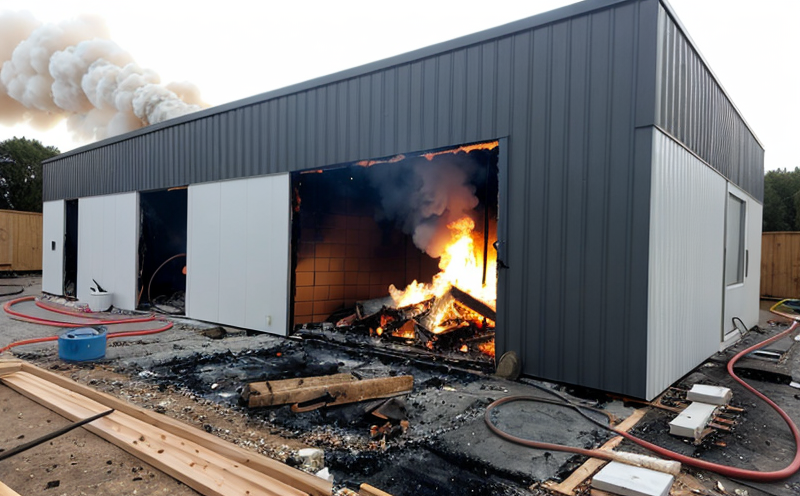Fire Endurance Testing of Facade Panels
The fire endurance testing of facade panels is a critical step in ensuring the safety and integrity of building structures. This test evaluates how well the facade panels can withstand exposure to intense heat and flames, simulating real-world fire conditions. In a typical fire scenario, the facade plays a crucial role in preventing the spread of fire from one part of a structure to another.
The standard procedure involves placing a specimen of the facade panel within a controlled environment where it is subjected to increasing temperatures. The test aims to determine how long the facade can continue to perform its function, specifically resisting the passage of flames and hot gases beyond a specified point. The performance criteria are based on European standards such as EN 1363-2 for cladding systems.
The testing process involves rigorous preparation of the specimen. This includes ensuring that all materials used in the panel meet the required specifications. Once prepared, the sample is placed into a furnace where it undergoes exposure to temperatures typically ranging from 500°C to 1,200°C over an extended period, usually between 30 minutes and several hours.
The test setup includes thermocouples for monitoring temperature distribution throughout the specimen. Other critical parameters include the rate of heat transfer, which is crucial in understanding how effectively the facade can insulate against fire spread. The testing process also involves observing the behavior of the panel under load conditions to ensure structural integrity.
After the test concludes, detailed reports are generated that provide a comprehensive analysis of the performance of the facade panels during the fire exposure. These reports include information on the duration for which the panel maintained its resistance properties, any signs of degradation or failure, and recommendations for improvements if necessary. This data is invaluable for architects, engineers, and building owners in making informed decisions about material selection and design.
Fire endurance testing is not just a compliance requirement but also serves as a critical tool for enhancing the safety and durability of buildings. By identifying weak points early on, stakeholders can take proactive measures to address issues that could compromise fire safety. This ensures that the built environment remains safe and resilient against potential threats.
Why It Matters
The significance of fire endurance testing cannot be overstated in today’s urban landscape, where high-rise buildings are common and the risk of fire is higher due to the volume of combustible materials. Ensuring that facade panels can withstand fire exposure is essential for several reasons:
Firstly, it protects lives by preventing the spread of fire within a building or between adjacent structures. Secondly, it helps protect property and assets from damage caused by fire. Additionally, compliance with international standards like EN 1363-2 ensures that buildings meet regulatory requirements, thereby protecting the reputation of developers and architects.
From an environmental perspective, fire-resistant facades contribute to sustainable urban planning by reducing potential losses due to fires. Moreover, these tests help in optimizing material selection and design for future projects, ensuring that new constructions are better prepared to handle fire incidents.
Eurolab Advantages
Eurolab stands out in the realm of fire endurance testing with its state-of-the-art facilities and experienced team. Our comprehensive services encompass everything from initial consultation to final report generation, ensuring a seamless process for our clients.
We utilize cutting-edge equipment that adheres strictly to international standards, providing accurate and reliable results every time. Our in-house experts bring deep industry knowledge and expertise, offering tailored advice on material selection and design based on the latest research and best practices.
In addition to technical excellence, Eurolab is committed to client satisfaction. We offer flexible scheduling options to accommodate tight project timelines and provide detailed feedback throughout the testing process. Our clients benefit from our commitment to quality assurance and continuous improvement in all aspects of our operations.
Why Choose This Test
Selecting fire endurance testing for facade panels is a strategic decision that offers numerous benefits:
First, it ensures compliance with stringent international standards such as EN 1363-2. Compliance not only avoids legal penalties but also enhances the reputation of the project stakeholders.
Secondly, this testing provides invaluable data for improving design and material selection. By identifying weaknesses early on, developers can make informed decisions that enhance fire safety without compromising aesthetics or cost-effectiveness.
Thirdly, it offers peace of mind to all parties involved in the project—from architects and engineers to property owners and occupants. Knowing that your facade meets rigorous testing ensures a safer environment for everyone.





